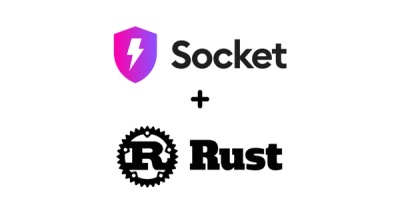
Research
/Security News
Critical Vulnerability in NestJS Devtools: Localhost RCE via Sandbox Escape
A flawed sandbox in @nestjs/devtools-integration lets attackers run code on your machine via CSRF, leading to full Remote Code Execution (RCE).
ionic4-auto-complete
Advanced tools

This is a component based on Ionic's search-bar component, with the addition of auto-complete ability. This component is super simple and light-weight. Just provide the data, and let the fun begin. This package is compatible with Angular 2+ and Ionic 2+.
npm install ionic4-auto-complete@^1.10.1 --save
npm install ionic4-auto-complete@~2.8.2 --save
npm install ionic4-auto-complete --save
assets array in angular.json:{
"glob": "**/*",
"input": "node_modules/ionic4-auto-complete/assets/",
"output": "./assets/"
}
Import AutoCompleteModule by adding the following to your parent module (i.e. app.module.ts):
import { AutoCompleteModule } from 'ionic4-auto-complete';
@NgModule({
...
imports: [
AutoCompleteModule,
...
],
...
})
export class AppModule {}
Import scss stylesheet from node_modules (i.e. app.scss, global.scss):
@import "~ionic4-auto-complete/auto-complete";
```
import {Component} from '@angular/core';
@Component({
selector: 'auto-complete-component',
templateUrl: 'auto-complete-component.component.html',
styleUrls: [
'auto-complete-component.component.scss'
],
})
export class AutoCompleteComponent {
public labelAttribute:string;
public objects:any[];
constructor() {
const objects = [
...
]
}
protected filter(keyword) {
keyword = keyword.toLowerCase();
return this.objects.filter(
(object) => {
const value = object[this.labelAttribute].toLowerCase();
return value.includes(keyword);
}
);
}
}
```
When implementing an AutoCompleteService interface, you must implement two properties:
import {Injectable} from '@angular/core';
import {HttpClient} from '@angular/common/http';
import {map} from 'rxjs/operators';
import {Observable, of} from 'rxjs';
import {AutoCompleteService} from 'ionic4-auto-complete';
@Injectable()
export class SimpleService implements AutoCompleteService {
labelAttribute = 'name';
private countries:any[] = [];
constructor(private http:HttpClient) {
}
getResults(keyword:string):Observable<any[]> {
let observable:Observable<any>;
if (this.countries.length === 0) {
observable = this.http.get('https://restcountries.eu/rest/v2/all');
} else {
observable = of(this.countries);
}
return observable.pipe(
map(
(result) => {
return result.filter(
(item) => {
return item.name.toLowerCase().startsWith(
keyword.toLowerCase()
);
}
);
}
)
);
}
}
To indicate that you don't want the label as value but another field of the country object returned by the REST service, you can specify the attribute formValueAttribute on your dataProvider. For example, we want to use the country numeric code as value and still use the country name as label.
Create a service which includes the formValueAttribute property.
import {Injectable} from '@angular/core';
import {map} from 'rxjs/operators';
import {HttpClient} from '@angular/common/http';
import {AutoCompleteService} from 'ionic4-auto-complete';
@Injectable()
export class CompleteTestService implements AutoCompleteService {
labelAttribute = 'name';
formValueAttribute = 'numericCode';
constructor(private http:HttpClient) {
}
getResults(keyword:string) {
if (!keyword) { return false; }
return this.http.get('https://restcountries.eu/rest/v2/name/' + keyword).pipe(map(
(result: any[]) => {
return result.filter(
(item) => {
return item.name.toLowerCase().startsWith(
keyword.toLowerCase()
);
}
);
}
));
}
}
Once the form is submitted the country is the selected country's numericCode while the displayed name is the labelAttribute.
Create a component:
import {Component} from '@angular/core';
import {NavController} from 'ionic-angular';
import {CompleteTestService} from '../../providers/CompleteTestService';
import {FormGroup, Validators, FormControl } from '@angular/forms'
@Component({
selector: 'page-home',
templateUrl: 'home.html'
})
export class HomePage {
myForm: FormGroup
constructor(public navCtrl: NavController, public completeTestService: CompleteTestService) {
}
ngOnInit(): void {
this.myForm = new FormGroup({
country: new FormControl('', [
Validators.required
])
})
}
submit(): void {
let country = this.myForm.value.country
}
}
* Add `ion-auto-complete` within the HTML of your parent module.
* Pass the data:
#### Option 1: Vanilla ####
<ion-auto-complete [dataProvider]="completeTestService"></ion-auto-complete>`
#### Option 2: Angular FormGroup ####
##### Option 2-A: Use property as form value #####
* Requires `labelAttribute` as both label and form value (default behavior).
* By default, if your **dataProvider** provides an array of objects, the `labelAttribute` property is used to take the good field of each object to display in the suggestion list. For backward compatibility, if nothing is specified, this attribute is also used to grab the value used in the form.
* Add form to the component's HTML and add the `formControlName` attribute:
```
<form [formGroup]="myForm"
(ngSubmit)="submit()"
novalidate>
<div class="ion-form-group">
<ion-auto-complete [dataProvider]="completeTestService"
formControlName="country"></ion-auto-complete>
</div>
<button ion-button
type="submit"
block>
Add Country
</button>
</form>
```
##### Option 2-B: Use whole object as form value #####
* Simply set `formValueAttribute` to empty string:
```
import {AutoCompleteService} from 'ionic4-auto-complete';
import {HttpClient} from '@angular/common/http';
import {Injectable} from "@angular/core";
import 'rxjs/add/operator/map'
@Injectable()
export class CompleteTestService implements AutoCompleteService {
...
formValueAttribute = ''
constructor(private http:HttpClient) {
...
}
getResults(keyword:string) {
...
}
}
```
autoFocus($event) is fired when the input is focused.autoBlur($event) is fired when the input is blured.ionAutoInput($event) is fired when user inputs.itemChanged($event) is fired when the selection changes (clicked).itemsHidden($event) is fired when items are hidden.itemRemoved($event) is fired when item is removed (clicked).itemSelected($event) is fired when item is selected from suggestions (clicked).itemsShown($event) is fired when items are shown.Ionic4-auto-complete supports the regular Ionic's Searchbar properties, which are set to their default values as specified in the docs.
You can override these default values by adding the [options] attribute to the <ion-auto-complete> tag, for instance:
<ion-auto-complete [dataProvider]="someProvider" [options]="{ placeholder : 'Lorem Ipsum' }"></ion-auto-complete>
Options include, but not limited to:
** color - (default is null)
** debounce - (default is 250)
** type - ("text", "password", "email", "number", "search", "tel", "url". Default "search".)
** placeholder - (default "Search")
To use ion-label position you must enable ion-input ([useIonInput]="true")
<ion-auto-complete [dataProvider]="service"
[label]="'This is a label'"
[labelPosition]="'floating'"></ion-auto-complete>
For best visual results use viewport size / fixed size ( in pixels).
ion-auto-complete {
width: 50vw;
}
You can display any attribute associated with your data items by accessing it from the data input class member in the template.
For example:
Let's assume that in addition to the country name, we also wish to display the country flag.
For that, we use the ng-template directive, which let's us pass the template as an input to the component.
Within your component's HTML add the a template:
<ng-template #withFlags let-attrs="attrs">
<img src="assets/image/flags/{{attrs.data.name}}.png"
class="flag"/>
<span [innerHTML]="attrs.data.name | boldprefix:attrs.keyword"></span>
</ng-template>
<ion-auto-complete [dataProvider]="service"
[template]="withFlags"></ion-auto-complete>
IMPORTANT: The attribute let-attrs is required.
In addition to the searchbar options, ion-auto-complete also supports the following option attributes:
[styles] (AutoCompleteStyles) - custom styles to be passed to ngStyle on elements within the Shadow DOM. Available element keys are: list; listItem; and searchbar.
[template] (TemplateRef) - custom template reference for your auto complete items (see below).
[emptytemplate] (TemplateRef) - custom template reference for your auto complete no items display.
[selectionTemplate] (TemplateRef) - custom template reference for your own selection display when using multi.
[clearInvalidInput] (boolean) - automatically clear the input field if a valid option is not selected from suggestions (Default true).
[showResultsFirst] (boolean) - for small lists it might be nicer to show all options on first tap (you might need to modify your service to handle an empty keyword).
[maxResults] (number) - limits the max number of suggestions shown (Default 8).
[alwaysShowList] (boolean) - always show the list - defaults to false).
[hideListOnSelection] (boolean) - if allowing multiple selections, it might be nice not to dismiss the list after each selection - defaults to true).
[selectOnTabOut] (boolean) - select the focused suggestion when the user presses the tab key (Default true)
[autoFocusSuggestion] (boolean) - Highlights the first suggestion (Default true)
Within your component:
@ViewChild('searchbar')
searchbar: AutoCompleteComponent;
```
Add #searchbar within your component's HTML:
<ion-auto-complete [dataProvider]="provider" #searchbar></ion-auto-complete>
getValue() returns the string value of the selected item.
this.searchbar.getValue()getSelection() returns the selected object.
this.searchbar.getSelection()setFocus() sets focus on the searchbar.
this.searchbar.setFocus()To contribute, clone the repo. Then, run npm install to get the packages needed for the library to work. Running gulp will run a series of tasks that builds the files in /src into /dist. Replace the /dist into whatever Ionic application's node_modules where you're testing your changes to continuously improve the library.
If you find any issues feel free to open a request in the Issues tab. If I have the time I will try to solve any issues but cannot make any guarantees. Feel free to contribute yourself.
npm install to get packages required for the demo and then run ionic serve to run locally.npm run docs:buildpackage.json files in both the root and dist/ directory following Semantic Versioning (2.0.0).npm run build from root.dist/ contents into demo/node_modules/ionic4-auto-complete/
cp -fr dist/* demo/node_modules/ionic4-auto-complete/ionic serve from demo/ionic build --prod from demo/npm publish from dist/ directory.CHANGELOG.md in root.The auto-complete component allows you to use templates for customize the display of each suggestion. But in many cases, the default template is good. However, you need to concatenate several fields (like firstname and lastname) to produce a full label. In that case, you can declare a method named getItemLabel instead of using labelAttribute.
For example, we want to display the country name and the population:
```
import {AutoCompleteService} from 'ionic4-auto-complete';
import {HttpClient} from '@angular/common/http';
import {Injectable} from "@angular/core";
import 'rxjs/add/operator/map'
@Injectable()
export class CompleteTestService implements AutoCompleteService {
formValueAttribute = ""
constructor(private http:HttpClient) {
}
getResults(keyword:string) {
return this.http.get("https://restcountries.eu/rest/v1/name/"+keyword)
.map(
result =>
{
return result.json()
.filter(item => item.name.toLowerCase().startsWith(keyword.toLowerCase()) )
});
}
getItemLabel(country: any) {
return country.name + ' (' + country.population + ')'
}
}
```
FAQs
README.md
The npm package ionic4-auto-complete receives a total of 320 weekly downloads. As such, ionic4-auto-complete popularity was classified as not popular.
We found that ionic4-auto-complete demonstrated a not healthy version release cadence and project activity because the last version was released a year ago. It has 1 open source maintainer collaborating on the project.
Did you know?

Socket for GitHub automatically highlights issues in each pull request and monitors the health of all your open source dependencies. Discover the contents of your packages and block harmful activity before you install or update your dependencies.

Research
/Security News
A flawed sandbox in @nestjs/devtools-integration lets attackers run code on your machine via CSRF, leading to full Remote Code Execution (RCE).

Product
Customize license detection with Socket’s new license overlays: gain control, reduce noise, and handle edge cases with precision.

Product
Socket now supports Rust and Cargo, offering package search for all users and experimental SBOM generation for enterprise projects.